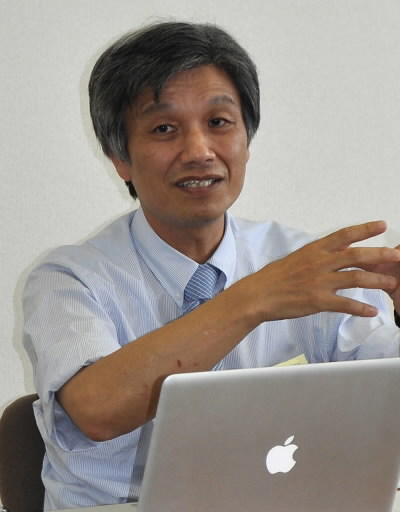Fukushima and Hiroshima: What must be done now, Part 5 [4]
Sep. 6, 2011
Article 4: Predict the onset of illness through use of the human genome
by Yo Kono, Staff Writer
The following are excerpts from an interview by Yo Kono, staff writer, with Tatsuhiko Kodama, professor at the Research Center for Advanced Science and Technology at the University of Tokyo.
The amount of radioactive materials that have leaked from the Fukushima No. 1 (Daiichi) nuclear power plant is far greater than the amount released by the atomic bomb that was dropped on Hiroshima. In terms of calorific value, it is equivalent to 29.6 Hiroshima atomic bombs, or 20 Hiroshima atomic bombs in terms of uranium 235. What concerns me most is the internal exposure to radiation among children and pregnant women, who are most susceptible to radiation.
10 years were needed to clarify effects
With regard to the A-bomb survivors, in the beginning no one knew what the effects of their radiation exposure would be. The findings of epidemiological research that followed certain groups then shed light on these effects. It took 10 years, though, to finally arrive at these findings. In the case of the accident that occurred in 1986 at the Chernobyl nuclear power plant, the increasing number of children developing thyroid cancer wasn't acknowledged until 20 years later. The methods employed to clarify the effects of radiation in these two cases could be considered emblematic of the 20th century.
But we are now in the 21st century. We have come to decode the genome, or the full genetic information, of the human body. As a result, we are now able to understand the effects of low-dose radiation exposure on the human body in scientific terms, as opposed to a theory of probability. In the case of Fukushima, it is incumbent upon us to make preparations now by predicting possible radiation disorders that may appear in the future so that the residents can avoid falling ill.
If analysis of the genome can result in an in-depth understanding of the mechanism by which cancer develops, this will lead to accurately diagnosing and preventing the illness, as well as detecting it early. Taking preventive measures against health disorders in each part and organ of the body is now a possibility.
For example, let's consider cesium 137, which has become a major concern. In the wake of the accident at Chernobyl, cases of abnormalities involving the bladders of residents in the vicinity of the plant were reported. This was due to the effects of their internal exposure to cesium 137.
Examinations conducted by the Ministry of Health, Labor and Welfare have found that the same level of cesium was detected in Fukushima, too. In this situation we have to do our utmost to detect such problems early by predicting the possible onset of bladder abnormalities in the future.
Thorough examinations are required
The level of radioactive contamination as a result of the atomic bombing of Hiroshima is believed to have declined to 1/1000th of the original level after a year had passed. Meanwhile, with the crippled nuclear plant releasing a large amount of radioactive materials with a long half-life, it is estimated that the level of radioactive contamination will decline to only about one 1/10th of the initial level after a year's time. This means that the people of Fukushima Prefecture must face the dangers of radiation exposure for a long period to come.
There isn't time to have the central government and experts discuss the safety standard for the radiation level of radioactive materials, over and over, whether it should be within one millisievert or 2o millisieverts per year. It is the mission of scientists to predict disorders involving radiation by utilizing state-of-the-art science and technology. We must devote ourselves to the work of a thorough decontamination of the affected areas and a thorough examination of foodstuffs. The collective efforts of everyone concerned, including scientists, politicians, and people in the media, are needed to protect children and pregnant women from internal exposure.
Tatsuhiko Kodama
Dr. Kodama was born in Tokyo in 1953. He is a graduate of the Faculty of Medicine at the University of Tokyo. He assumed his current position as professor at the Research Center for Advanced Science and Technology at the University of Tokyo in 2004 after working as a researcher at the Massachusetts Institute of Technology, among other roles. Dr. Kodama also serves as the head of the Radioisotope Center at the University of Tokyo. His specialty is Systems Biology and Medicine. He is a resident of Setagaya Ward, Tokyo.
(Originally published on August 31, 2011)








